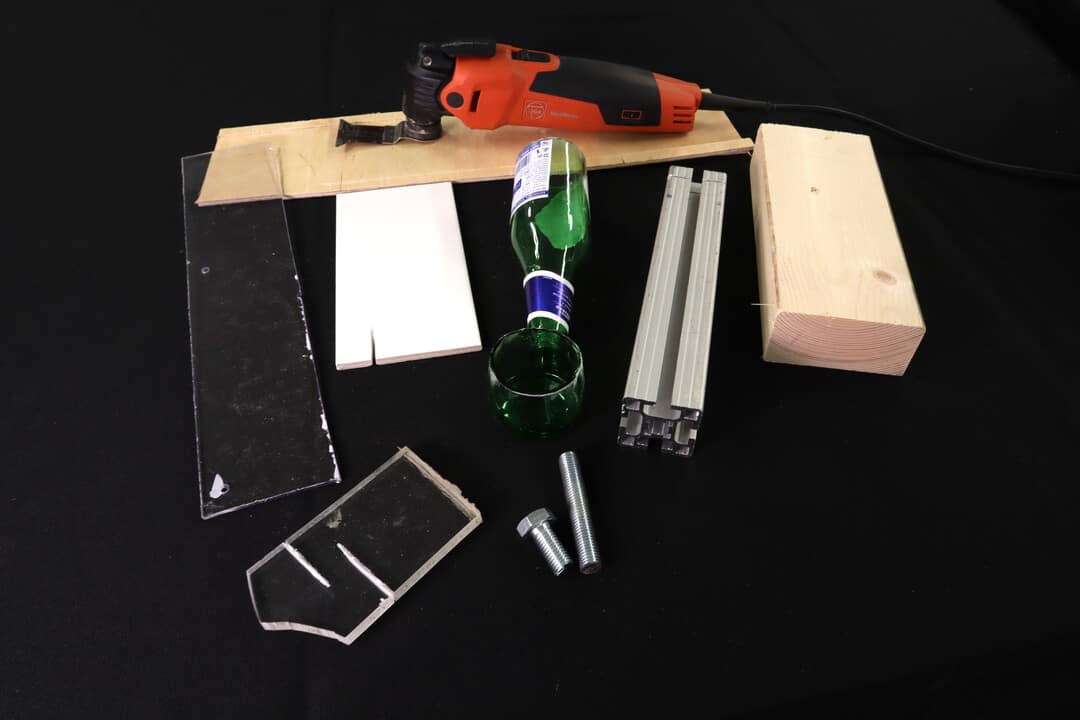Oscillating multi-tools are very versatile machines. Variously called oscillating tools, oscillating power tools, multi-tools, or oscillating multi-tools, these compact wonders of functionality can sand, grind, rasp, scrape and polish. In terms of frequency of use, their number one function is still undoubtedly cutting.
But what exactly can oscillating multi-tools cut? An MDF baseboard, surely, but how about a two-by-four? Hard copper pipe? Or a stainless steel bolt? And which type of blade should you use for each material?
Whether you are considering purchasing an oscillating power tool, or just getting new blades for your machine, you may be asking these questions. And for a good reason: trying to go beyond the capacity of the tool will only waste time and material, and leave you with an ugly half-finished cut. Using the wrong blade, on the other hand, will not only lead to inefficient cutting, but may also ruin the blade.
In this article, I present an extensive list of all the materials that oscillating multi-tools can cut. The list is based on my experience in using these tools for the past 4 years. For each material, I will also give comments on cutting capacity, the ease of cutting and working technique.
Summary
The list of materials is long, and for easier browsing I have divided it into four categories:
The materials and a recommended blade for each are also listed in the table below, which works as a table of contents for the article.
| OSCILLATING MULTITOOL CUTTING Material | Blade (recommend.) | Notes |
|---|---|---|
| 1 Wood products | ||
| –Wood –Wood sheets | Bi-metal saw Bi-metal saw | |
| 2 Metals | ||
| –Aluminum –Bolts -Machine screws –Copper –Metal –Nails –Rebar –Screws –Sheet metal –Stainless steel –Steel | Bi-metal saw Carbide saw Carbide saw Bi-metal saw Carbide saw Bi-metal saw Carbide saw Carbide saw Carbide saw Carbide saw Carbide saw | – B-M* OK for low grades B-M OK for low grades Carbide for hard alloys B-M OK for soft metals B-M OK for low grades – – – – B-M OK for unhardened |
| 3 Ceramics | ||
| –Brick –Ceramic tile –Concrete –Drywall –Glass –Granite –Grout –Marble –Mortar –Plaster –Porcelain –Stone | Carbide saw Carbide saw Carbide saw Bi-metal saw D/C** grit D/C grit D/C grit Carbide saw D/C grit Bi-metal saw D/C grit D/C grit | – slow to cut – – slow to cut slow to cut – – – – slow to cut – |
| 4 Plastics | ||
| –Acrylic (PMMA) –Polycarbonate (PC) –PVC | Bi-metal saw Bi-metal saw Bi-metal saw | |
| 5 Composite | ||
| –CFRP –Fiberglass | Carbide saw Carbide saw | |
| *Bi-metal | **Diamond/Carbide |
Tools
I have assembled recommended oscillating multi-tool blades into the table below. Included also a link (affiliate) to Amazon whenever possible. (Workshoppist.com is an Amazon Associate. As an Amazon Associate we earn from qualifying purchases.)
| OSCILLATING MULTITOOL CUTTING BLADES |
|---|
| Essential: Bi-Metal saw 1-1/4″* (Bosch Starlock) Carbide saw 1-1/4″ (Bosch Starlock) Carbide grit 3-½” (Bosch Starlock) |
| Optional: Bi-metal saw 2-½” (Bosch Starlock) Segment saw 3-½” (Bosch Starlock) |
| Tool: Fein FMM350QSL (corded) Bosch GOP18V-28N (cordless) |
| *links to Amazon |
1 Wood and wood products
Wood, all species
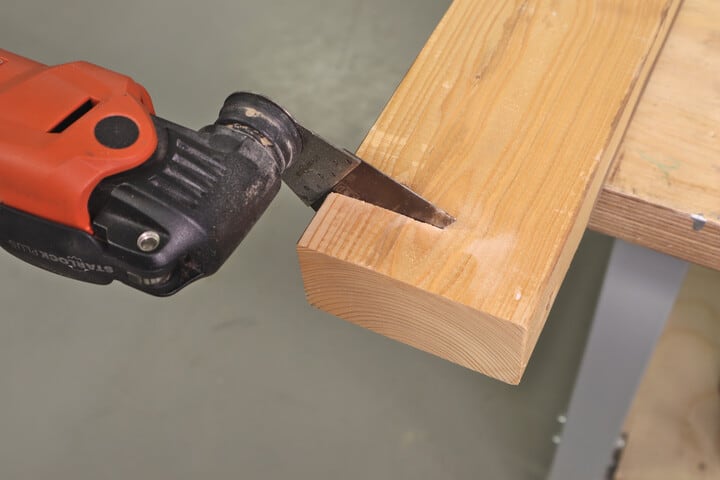
An oscillating multi-tool can cut all species of hard and soft woods. In fact, wood is one of the easiest materials to cut with this tool. You can use any saw blade type – carbon steel, bi-metal or carbide – with wood, although the bi-metal blades with slightly larger teeth and some set will be most efficient cutters.
Rather than the material, the limiting factor in cutting lumber with an oscillating multi-tool is the thickness of the cross section to be cut. Two basic cutting approaches are possible:
1 Two-sided cutting: sawing first from one side of the piece of lumber and then from the other. Here, you need to make sure your plunge cut blade will be long enough to reach at least midway through the piece, so that you are able to cut the entire cross section by working from two sides. Note that this requires you to have access to the piece from two directions, which is not always the case when trimming pieces already fixed to an assembly.
2 One-sided cutting: For more efficient work, a blade that will reach all the way through the thickness of the piece of lumber is a better choice. This allows you to cut it working from one side, and is the only way to go if you cannot get to the other side.
Note that the width of the lumber cross section is actually not critical for cutting with an oscillating multi-tool: you start from one edge of the board or beam, and saw one blade width at a time.
So what kind of lumbers can you actually cut with an oscillating multi-tool using the standard plunge cut blades? The table below shows which blades can cut through which thickness of lumber, and whether one- or two-sided cutting is required.
| Blade: | Lumber thickness -> | 1” | 1½” | 2” | 3” | 4” | 5” |
|---|---|---|---|---|---|---|---|
| Segment saw | 3½” 4” | 2s 1s | 2s 2s | – 2s | – – | – – | – – |
| Plunge- cut saw | 3” 3-1/4” 3-½” | 1s 1s 1s | 1s 1s 1s | 1s 1s 1s | 1s 2s 1s | – 2s 2s | – – 2s |
As you see in the table, most of the standard 3″ to 3½” long plunge cut blades can cut wood panel and board under 1½” in thickness from one side, and 2×4’s, planks and beams under 3″ in thickness from two sides. However, planks and beams thicker than 3’’, such as 4x4s, can be cut only with the longest 3½” plunge cut blades. Lumber thicker than 4’’ cannot be cut with the typically available plunge cut blades at all.
In general, an oscillating multi-tool is not the fastest tool for cutting lumber: most cross-cutting – and certainly all ripping – is done quicker and more accurately using circular saws, reciprocating saws or jigsaws. However, they are very versatile, and often the best choice for flush cuts, small pockets and reliefs, and cuts in very tight spots. Moreover, they are the only saw that can cut small square or rectangular holes.
Wood sheets
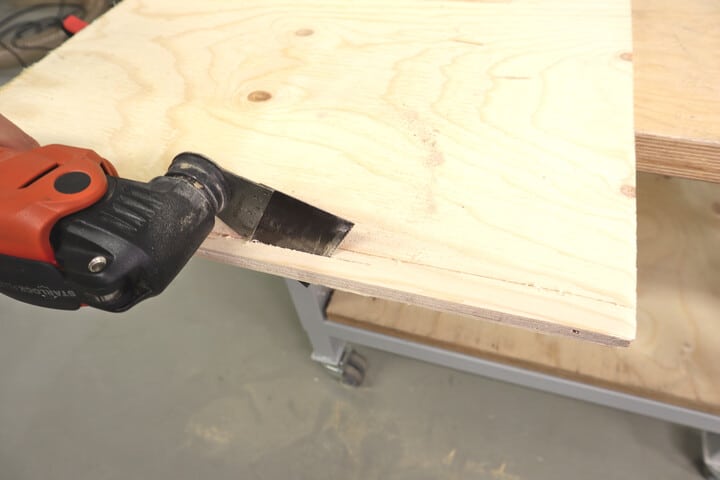
Just as solid wood, an oscillating multi-tool can cut all common wood product sheets such as plywood, MDF, particleboard, and OSB. The recommended blade type is a bi-metal plunge cut or segment saw blade. Melamine-laminated wood product sheets can be cut with the same blade and techniques, but wear the blade down faster.
The same cutting capacity restrictions apply as with solid wood:
- In two-sided cutting, the blade must reach at least half way through the sheet thickness
- In one-sided cutting, the blade must reach through the sheet thickness
As sheet goods 2” thick or thicker are very rare, most plunge cut blades can easily cut through wood product sheets from one side. Segment saws, on the other hand, usually have a reach of only 3/4” to 1”, and are limited to use with relatively thin sheets only.
The best technique to cut sheet goods with an oscillating multi-tool is running through the cut with the blade at roughly a 45 degree angle to to sheet. To avoid excessive vibration of the sheet, it should be supported close to the cut line for the length of the cut.
Oscillating multi-tools are not very efficient in cutting sheet goods, and longer cuts are much better made with circular saws. However, oscillating tool are excellent in making small details such as reliefs, cutouts and holes. They are the only tool that can make a square hole to the middle of a sheet.
2 Metals
Aluminum, all alloys
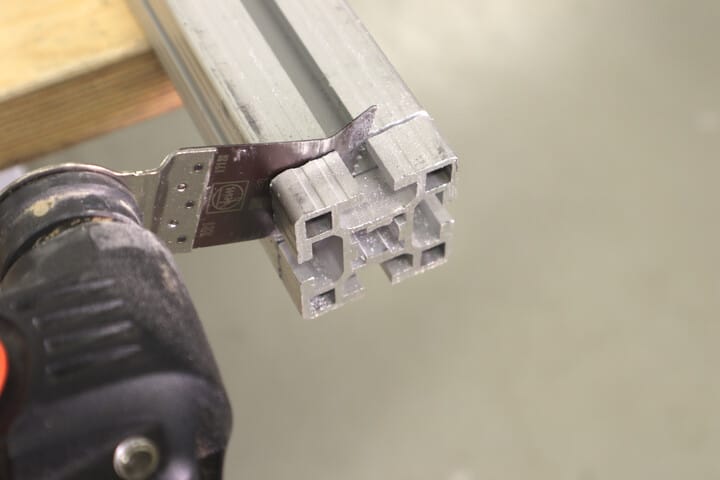
An oscillating multi-tool can be used to cut aluminum. All common aluminum alloys are relatively soft compared to most steels, and can be easily cut using bi-metal plunge-cut and segment saw blades intended for metal. With significant set and larger teeth, these blades allow for good chip removal and cutting efficiency. While carbide saw blades may also work, aluminum has a tendency to clog up their smaller and non-set teeth, which reduces their efficiency.
The cutting capacity of oscillating multi-tools is rarely a limiting factor with aluminum. The common plunge-cut blades with reaches between 1½” and 2” can cut through most aluminum bar, profile and sheet without difficulty. Even the lower-reach segment saw blades can easily saw most of the common sheets.
When cutting aluminum with an oscillating multi-tool, the workpiece should be firmly clamped close to the cut to avoid vibration. Thin and lightweight profiles are particularly susceptible flexing under the cutting forces, which reduces cutting efficiency and may cause the tool to jump around. Thin aluminum sheets are best cut on a sacrificial support, see Sheet metal below.
Cutting aluminum with an oscillating multi-tool is not very fast or accurate, and thus not well suited to long straight cuts. However, an oscillating multi-tool may be an excellent choice small cross-cuts, holes, inside corners and other details. It also has an exceptional capability to make cuts flush to a large surface or in otherwise restricted space, where no other cutter will fit.
Bolts and machine screws
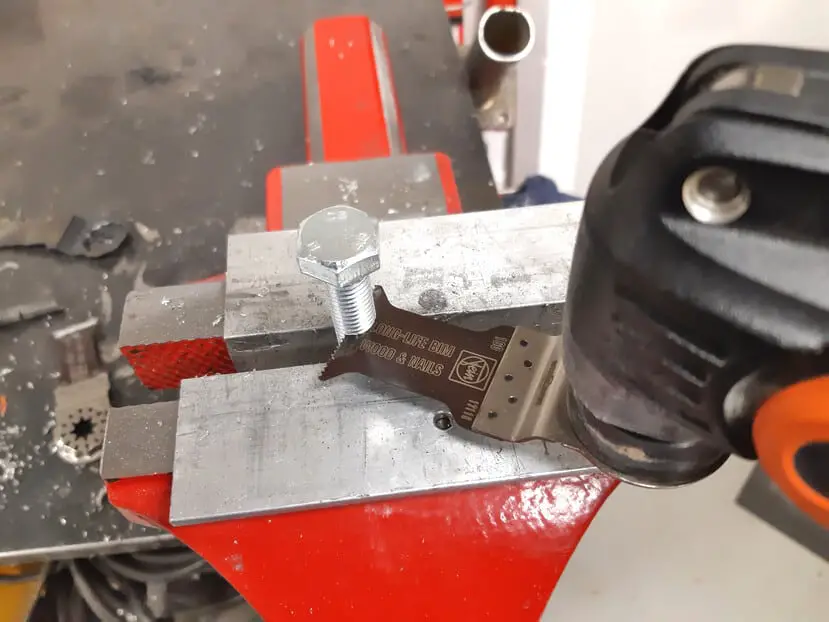
An oscillating multi-tool can be used to cut machine screws and bolts. Bolts come in different strength classes, which determined the ease of cutting. Lowest strength bolts are easy to cut with a bi-metal saw blade, but higher categories and stainless steel bolts should preferably be cut with carbide saws. See table below for which blade to use with which strength class.
| OSCILLATING MULTITOOL FOR BOLTS Bolt class | Bolt strength grade | Recommended blade* |
|---|---|---|
| SAE | Grade 2 Grade 5 Grade 8 | Bi-metal Carbide Carbide |
| Metric | 4.8 6.8 8.8 10.9 12.9 | Bi-metal Bi-metal Carbide Carbide Carbide |
| Stainless | A2 A4 | Carbide Carbide |
| *links to Amazon |
The cutting capacity of oscillating multi-tools is rarely a limiting factor in cutting bolts. The common plunge-cut blades with reaches between 1½” and 2” can cut through all common bolt sizes from one side.
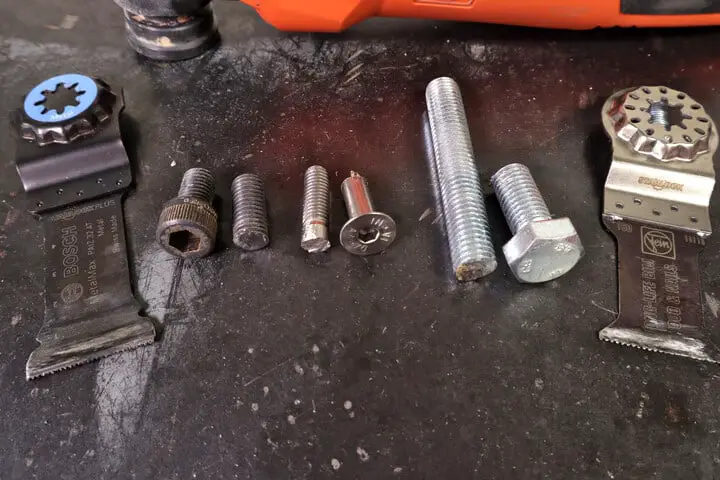
When cutting bolts with an oscillating multi-tool, the bolt or screw should preferably be supported close the cut to avoid vibration. This is particularly important with small screws, which are easily thrown around by the oscillating blade.
Cutting bolts with an oscillating multi-tool is not fast, but it is very flexible. The tool allows you to cut bolts already screwed in in an assembly, even in restricted spaces where a reciprocating saw, a hack saw or an angle grinder would not fit. An oscillating multi-tool also has the exceptional capability of cutting a bolt exactly flush to a surface – a feature which may come in handy when trimming protruding screw tips or removing a stuck bolt by cutting the head off.
Copper, common alloys
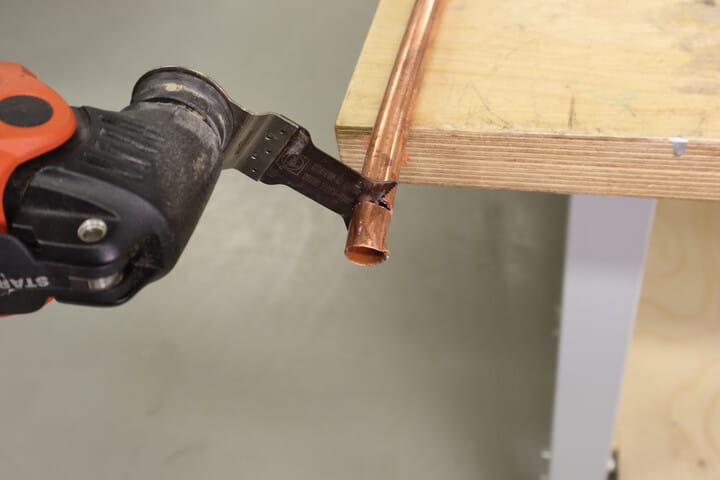
An oscillating multi-tool can be used to cut copper. Most common copper alloys, such as those used in electric wires, water pipes and heat exchangers, are relatively soft with tensile strength between 30 and 50 ksi (200…350 MPa). These alloys can be cut easily using bi-metal plunge-cut and segment saw blades intended for metal. Carbide saw blades also work, but are not really needed for copper.
The cutting capacity of oscillating multi-tools is rarely a limiting factor with copper. The common plunge-cut blades with reaches between 1½” and 2” can cut through most wires, cables and pipes without difficulty. Even the lower-reach segment saw blades can easily saw most of the common copper sheets.
Most of the copper encountered by builders and hobbyists – wire, cable, pipe – is long stock. The cuts into copper will thus usually be small cross-cuts. An oscillating multi-tool is an excellent choice these jobs, and also has an exceptional capability to make cuts flush to a large surface or in otherwise restricted space, where no other cutter will fit.
Although most copper is relatively soft metal, there are a few high-strength copper alloys such as beryllium–copper, which may have tensile strengths in excess of 150 ksi (1000 MPa). Such alloys should be cut using carbide saw blades, as they will quickly dull the teeth on bi-metal saws.
Metal
An oscillating multi-tool can be used to cut most common metal objects. Soft metals, such as aluminum, copper and mild steel, can be cut with bi-metal saw blades. Harder metals, such as hardened or stainless steels, titanium, and high-strength non-ferrous alloys, should be cut with carbide saw blades. For more specific information on specific metals, see Aluminum, Copper, Steel, Stainless steel; for certain common metal products, see Bolts, Nails, Rebar, Screws and Sheet metal.
Nails
An oscillating multi-tool can be used to cut nails. Nails for wood are usually soft mild steel with a tensile strength clearly below 100 ksi (700 MPa), and can be cut using both bi-metal and carbide saw blades.
Much harder nails intended for fastening to concrete or masonry also exist and may have a hardness up to 55 HRC. These nails will dull the teeth on bi-metal blades, and should be cut only with carbide saw blades.
Oscillating multi-tools have more than enough cutting capacity for all nails. They are excellent in allowing you to trim off protruding nail tips and heads neatly flush to the face of a board.
Rebar
An oscillating multi-tool can be used to cut rebar. Rebar is universally made of carbon steel, but comes in different strength grades. Rebar in the lowest US strength grades 40 and 60 is easy to cut with a bi-metal saw blade. The higher strength grades 75, 80 and 100, however, should preferably be cut with carbide blades instead. See table below for which blade to use with which strength class.
| OSCILLATING MULTITOOL FOR REBAR Grade system | Grade | Recommended blade* |
|---|---|---|
| US grades | 40 60 75 80 100, up | Bi-metal saw Bi-metal saw Carbide saw Carbide saw Carbide saw |
| Metric grades | <420 >520 | Bi-metal saw Carbide saw |
| *link to Amazon |
The cutting capacity of oscillating multi-tools is rarely a limiting factor in cutting rebar. The standard plunge-cut blades with reaches between 1½” and 2” can cut through all common bolt sizes from one side. Small-diameter rebar will need support close to the cut to avoid excessive vibration.
An oscillating multi-tool may not be the fastest tool for cutting rebar, but it is very flexible. The tool allows you to cut rebar in restricted spaces where saws, grinders or bolt cutters may not fit. An oscillating multi-tool can also cut rebar exactly flush to a surface – a feature which may come in handy when trimming off unnecessary rebar ties sticking out of a finished concrete slab.
Screws, wood-
An oscillating multi-tool can be used to cut wood screws. With material tensile strengths ranging from about 70 to 140 ksi (500 to 900 MPa), the common steel wood screws are, on average, slightly harder than nails.
While the softer screws could be successfully cut with bi-metal saw blades, the stronger ones are best cut with carbide saws for optimal blade life. The challenge is that there are no established strength grades or markings for wood screws, and so the actual material strength is not easy to tell. For this reason, I recommend using a carbide saw blade, if available, for all wood screws.
Wood screws are usually relatively light gauge and are easy and fast to cut with an oscillating multi-tool equipped with the right kind of blade. An oscillating multi-tool is excellent trimming off the tips of overlong screws that protruding out of a board, as it can do this neatly flush to the board face, unlike most other saws or pliers. It can also be used to make a plunge cut into the tight gap between two pieces of lumber to release a screw joint that cannot otherwise be opened.
Sheet metal
An oscillating multi-tool can be used to cut sheet metal. The type of blade you need is determined by the sheet material: bi-metal saws can be used for softer metals such as aluminum, brass, copper and mild steel, while hardened steel and stainless steel should be cut with carbide saws. Both plunge-cut and segment saw blades can be used, but the segment saws provide stabler cutting.
The main challenge in cutting sheet metal is workpiece stability. The sawing forces must usually be oriented obliquely out of the plane of the sheet and tend to flex the sheet up and down. This flexing may lead to inefficient cutting, excessive noise and kickback in the tool. The issue is particularly severe with thin sheets.
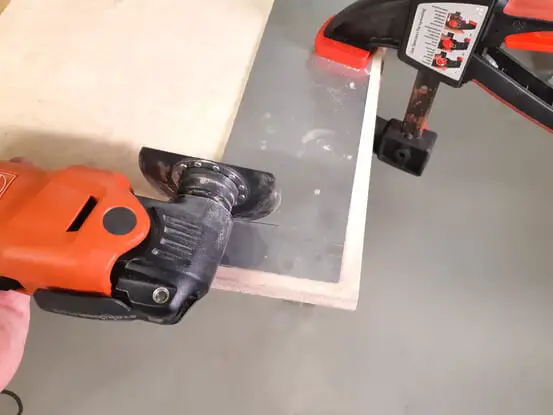
You can often stabilise the sheet for cutting by clamping it close to the cut line for its entire length. Alternatively, the sheet can be clamped against a thicker sacrificial sheet of plywood, as illustrated in the image above.
Cutting sheet metal with an oscillating multi-tool is not very fast. However, an oscillating multi-tool is relatively flexible in terms of material and cut geometry, comparatively safe and mostly non-sparking. It also leaves both sides of the cut clean and unbent.
Stainless steel
An oscillating multi-tool can be used to cut stainless steel. Most stainless steel alloys are very tough and work-hardening, which leads to high cutting forces and heat generation. Stainless steel is therefore best cut with carbide saw blades, which can take the high cutting temperatures without softening. You may have some success with bi-metal saws, but their useful life in cutting stainless steel will be short.
The cutting technique to be used with stainless steel depends on the shape of the product. Bolts, screws and pipe are easy to cut; for more information on cutting stainless steel sheets, see Sheet metal.
Steel
An oscillating multi-tool can be used to cut most steels. Different steel alloys vary greatly in strength and hardness and therefore in ease of cutting. The softest unhardened low-carbon and low-alloy steels are relatively easy to cut both with bi-metal and carbide saw blades. Medium-strength hardened steels such as that found in high strength grade bolts are already somewhat harder, and should preferably be cut with carbide saw blades. On the other hand, the very highest strength alloy and tool steels may be hard or impractical to cut even with carbide blades.
For more information on cutting different steel products, see Bolts, Nails, Rebar, Screws, Sheet metal, Stainless steel.
3 Ceramics
Brick
Brick, or precisely clay brick, is a relatively soft coarse ceramic material, and can be easily cut with an oscillating multi-tool. Although soft, brick is abrasive due to the hard minerals contained, and should preferably be cut with a carbide plunge-cut or carbide or diamond grit segment blade to avoid fast blade wear. Bi-metal saw blades will also work, but will dull relatively quickly.
Common face bricks with thicknesses between 2” and 3” can be cut using standard 1½” to 2” plunge-cut blades, but will in most cases require cutting from two sides. The same applies to perforated bricks with the same cross section. Brick roof tiles are usually thinner than ½”, and can be cut also with segment saw blades.
There are no particular restrictions on how bricks can be cut with an oscillating multi-tool. Bricks are stiff and do not flex under the cutting forces, which allows the cut to proceed steadily regardless of the orientation.
Ceramic tile
An oscillating multi-tool can be used to cut ceramic tiles. These tiles are hard and abrasive and should preferably be cut with diamond grit saw blades. Carbide-tipped blades may also work, but will suffer from a higher wear rate.
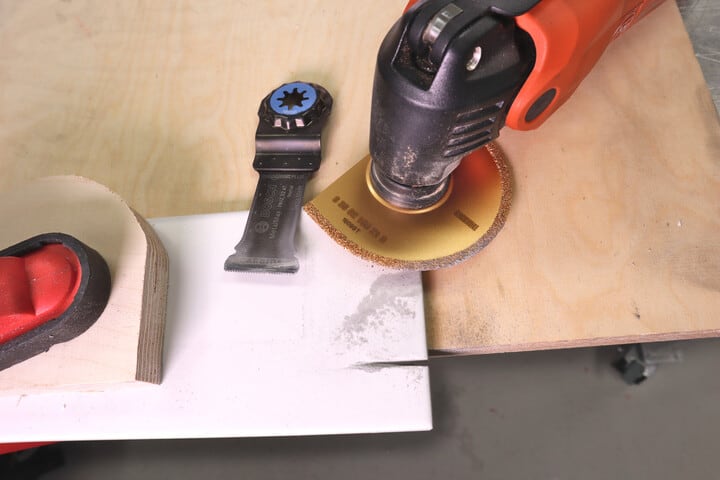
Ceramic tiles are usually quite thin and present no particular challenge in terms of cutting capacity. Most plunge-cut and segment type blades will reach through the typical tile thicknesses below 1/2” from one side without any issues.
Ceramic tiles are brittle, though, and must be cut carefully to avoid cracking them. During cutting, the tile should be stiffly supported very close to the cut line to avoid vibration or large bending stresses in the tile. The cutting process is similar to grinding and generates very fine dust, and you should take care of proper dust extraction and wearing the appropriate PPE. Dust can also be mitigated by wetting the tile, which also decreases the blade temperature at the cutting point and extends the blade life.
Cutting ceramic tiles with an oscillating multi-tool is very slow and not very accurate. It is thus not well suited to large-volume straight splitting of tile rows, for example, which is much better done with dedicated ceramic tile cutters. However, an oscillating multi-tool is excellent for detailed tile work such as small cutouts, holes, pockets and reliefs, which may be difficult or impossible to make with other tile cutting methods.
Concrete
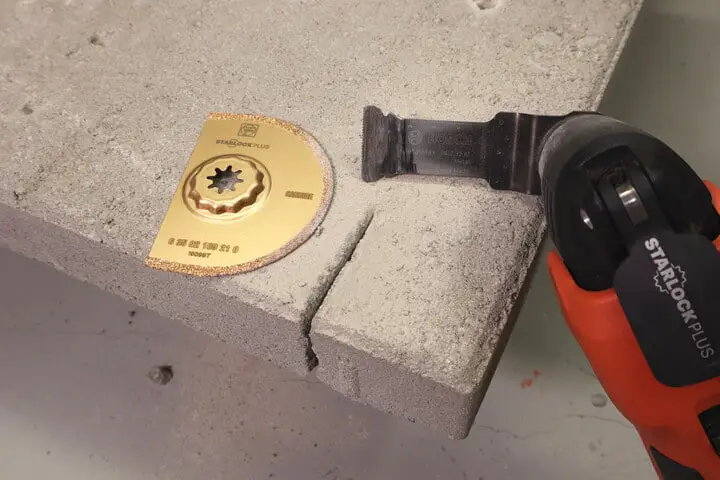
An oscillating multi-tool can be used to cut concrete. Due to the hard minerals in the aggregate (sand, gravel, and crushed rock) concrete is very abrasive for the blades. For this reason, concrete should preferably be cut with diamond grit saw blades. Carbide-tipped blades may also work, but will suffer from a higher wear rate.
Cutting capacity of oscillating multi-tools into concrete is limited by the reach of the blade used. Diamond and carbide grit segment saws best suited for concrete have a reach between 3/4” and 1”. Deeper cuts may be possible with carbide plunge-cut blades, which are available with effective lengths up to 2”. These blades are not usually intended for concrete, however, and may not be very efficient or long-lasting in this use. Further, you should note that even a cutting depth of 2” is not very much compared to the usual thicknesses of concrete features.
Cutting concrete with an oscillating multi-tool is stable and easy, as concrete objects and structures are usually massive and workpiece flexing therefore rarely an issue. The cutting process is similar to grinding and generates very fine dust, and you should take care of proper dust extraction and wearing the appropriate PPE. Dust can also be mitigated by wetting the concrete prior to cutting, which also decreases the blade temperature at the cutting point and extends the blade life.
Although not difficult, cutting concrete with an oscillating multi-tool is relatively slow. As such, it cannot compete in cutting capacity or productivity with other tools. However, an oscillating multi-tool is excellent for detailed concrete finishing work such as small cutouts, holes, pockets and reliefs, which may be difficult or impossible to make with other cutting methods.
Drywall
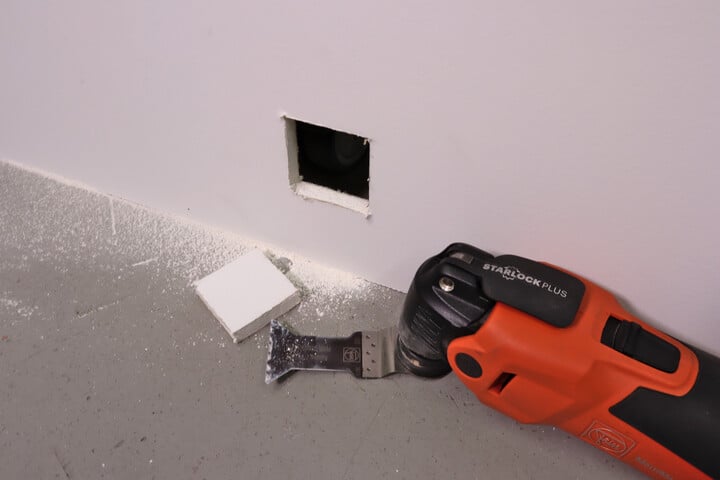
An oscillating multi-tool can be used to cut drywall. Consisting of gypsum, some additives and two backer papers, drywall is soft and easy to cut through. Drywall can be cut with all plunge-cut and segment saw blades intended for wood or metal. Sheets with fiberglass or abrasive fillers can be cut with all saw blades, but carbide saws should be preferred for best blade life.
Cutting capacity of oscillating multi-tools into drywall is not limiting in most cases. Common panel thicknesses ½” and 5/8” can be cut with all common segment saws with reaches between 3/4” and 1”. Plunge-cut blades can cut through all available thicknesses up to 1”, and also double layers of the standard thicknesses.
Cutting drywall with an oscillating multi-tool is stable and easy, and there are no particular restriction on cutting technique. The cutting process does generate fine dust, and you should take care of proper dust extraction and wearing the appropriate PPE.
Because of the relatively slow cutting speed and lack of guiding, an oscillating multi-tool is not very efficient in resizing sheets and other long straight cuts. Instead, an oscillating multi-tool is excellent for cutting details such as small cutouts for pipes, holes, pockets and reliefs, which may be difficult or impossible to make with other cutting methods. It is also one of the very few tools capable of making small square holes into the middle of a larger sheet of drywall.
Glass
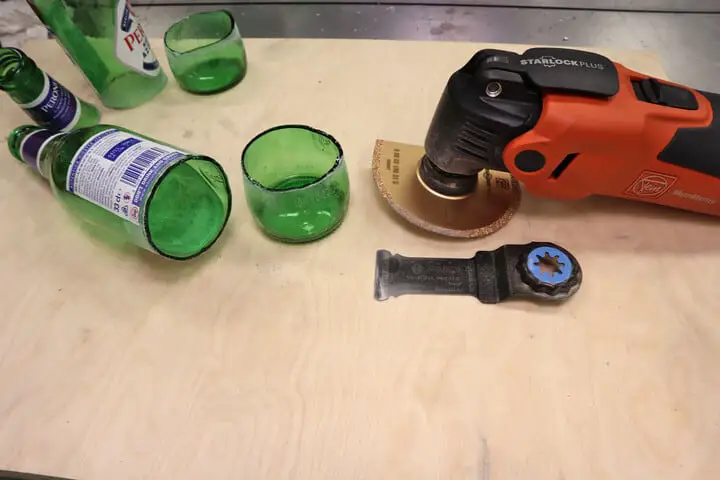
An oscillating multi-tool can be used to cut glass. Common soda-lime and borosilicate glasses used in windows and household wares have Mohs hardnesses between 6 and 7, and should preferably be cut with diamond or carbide grit saw blades. Carbide saws may also work, but will suffer from a higher wear rate.
Cutting capacity: Most glass items are thin-walled and present no particular challenge to oscillating multi-tools in terms of cutting capacity. Most plunge-cut and segment type blades will reach through the typical tile thicknesses below 1/4” from one side without any issues.
Cutting technique: Instead, the real challenge in cutting glass with an oscillating multi-tool is that the cut proceeds very slowly and the glass workpieces are very easily cracked or shattered during cutting. Further, due to the high hardness, the tool does not quickly bite into the material, and is also prone to wandering during the cut.
For best results, glass workpieces should be firmly supported close to the cut, and the contact angle between the glass and the blade adjusted so as to minimize vibration and ringing in the workpiece. To avoid blade wandering, it is often advisable to guide the cut with a sacrificial strip of material on top of the workpiece; alternatively, the oscillating tool may be mounted on a holder, and the workpiece guided through the cut instead.
As cracking may sometimes occur in the workpiece in spite of all efforts to avoid it, it often makes sense to start the cut by lightly scoring the whole cut line with the tool: with enough luck, this scored line will guide the crack to go along the intended cut line.
Safety: Cutting glass with an oscillating multi-tool generates very fine dust, and you should take care of proper dust extraction and wearing the appropriate PPE. Dust can also be mitigated by wetting the glass, which also decreases the blade temperature at the cutting point and extends the blade life.
Applications: Cutting glass with an oscillating multi-tool is very slow, not very accurate, and risks cracking the workpiece. It is thus not well suited to long, straight or accurate cuts, such as resizing window panes. However, an oscillating multi-tool may be a good alternative for small noncritical glass work.
Granite
An oscillating multi-tool can be used to cut granite. Due to its high hardness between 6 and 7 on the Mohs scale, granite should preferably be cut using diamond grit segment saws. Carbide-tipped blades may also work, but will suffer from a higher wear rate.
Cutting capacity of oscillating multi-tools into granite is limited by the reach of the blade used. Diamond and carbide grit segment saws best suited for very hard materials have a reach between 3/4” and 1”. Deeper cuts may be possible with carbide plunge-cut blades, which are available with effective lengths up to 2”. These blades are seldom rated for granite, however, and may not be very efficient or long-lasting in this use.
Granite is relatively brittle and may shatter if subjected to tension loads or impacts. Workpiece holding should therefore be carefully considered when cutting it with an oscillating multi-tool: the granite workpiece should be clamped very securely close to the cut to avoid bending stresses and vibration which may lead to cracking of the piece.
The cutting process is similar to grinding and generates very fine dust, and you should take care of proper dust extraction and wearing the appropriate PPE. Dust can also be mitigated by wetting the stone prior to cutting, which also decreases the blade temperature at the cutting point and extends the blade life.
Cutting granite with an oscillating multi-tool is slow, and cannot compete in cutting capacity or productivity with other tools. An oscillating multi-tool is therefore best suited for detailed granite finishing work such as small cutouts, holes, pockets and reliefs, which may be difficult or impossible to make with other cutting methods.
Grout
An oscillating multi-tool can be used to cut grout. While not exceptionally hard on a macro scale, grout typically contains sand, which makes it very abrasive and tough on the blades. For this reason, grout is best cut with diamond grit saws and rasps. Carbide saws can also be used, but suffer from a faster wear.
Cutting capacity of oscillating multi-tools into grout is rarely a limiting factor, since grout seams are mostly very shallow – all plunge-cut and segment blades have more than enough reach to get through the seam thickness.
Grout is most often cut, not as a piece on its own, but from between tiles in tile floors or walls in grout removal. The grout and the tiles are stiffly supported by the underlying floor or wall, and workpiece supporting, vibration or shattering are rarely an issue. However, the grinding-type cutting process generates fine dust, and you should take care of proper dust extraction and wearing the appropriate PPE.
Marble
An oscillating multi-tool can be used to cut marble. Marble is a soft rock with a Mohs hardness around 3, and is easy to with carbide, bi-metal or even carbon steel plunge-cut and segment saw blades.
Cutting capacity of oscillating multi-tools into marble is limited by the reach of the blade used. Segment saw blades have a limited reach between 3/4” and 1”. Much deeper cuts can be made with plunge-cut blades, which are available with effective lengths up to 2”.
While marble is less prone to shattering than many other rocks, some care should still be taken to ensure supporting the workpiece close to the cut, and that cutting forces cannot bend the workpiece over a substantial length. The cutting process generates semi-fine dust, and you should take care of proper dust extraction and wearing the appropriate PPE.
Cutting marble with an oscillating multi-tool is not fast, though, and also not very accurate. For this reason, it is not the best method for long straight cuts into marble sheet. But the multi-tool is very flexible and controllable, which makes it an excellent choice for cutting small details like holes, cutouts, and corners.
Mortar
An oscillating multi-tool can be used to cut mortar. While not exceptionally hard on a macro scale, mortar typically contains sand, which makes it very abrasive and tough on the blades. For this reason, mortar is best cut with diamond grit saws. Carbide saws can also be used, but suffer from a faster wear.
Cutting capacity of oscillating multi-tools into mortar is limited by the reach of the blade used. Segment blades have a limited reach between 3/4” and 1”. Much deeper cuts can be made with plunge-cut blades, which are available with effective lengths up to 2”.
Mortar is most often cut, not as a piece on its own, but from between bricks or stones in a masonry wall in a process called raking. The masonry work is typically massive compared to the average workpiece, and workpiece supporting, vibration or shattering are rarely an issue. However, the grinding-type cutting process generates fine dust, and you should take care of proper dust extraction and wearing the appropriate PPE.
As in most other applications, an oscillating multi-tool does not provide the highest cutting capacity or efficiency in mortar raking. However, it does offer more control in mortar cutting than impact-based or rotary tools, and is a good choice for smaller cuts and going around tricky details.
Plaster
An oscillating multi-tool can be used to cut plaster. Plaster is a very soft ceramic material with a Mohs hardness around 2, and can be easily cut with any oscillating multi-tool blade. Bi-metal or carbon steel segment and plunge-cut blades are recommended for best cutting efficiency.
Cutting capacity of oscillating multi-tools into plaster is limited by the reach of the blade used. Segment saw blades have a limited reach between 3/4” and 1”. Much deeper cuts can be made with plunge-cut blades, which are available with effective lengths up to 2”.
Plaster is relatively brittle and prone to shattering. When cutting it with an oscillating multi-tool, care should be taken to support the workpiece gently but firmly close enough to the cut. The cutting process generates semi-fine dust, and you should take care of proper dust extraction and wearing the appropriate PPE.
Oscillating multi-tools are excellent for cutting plaster – in fact, cutting orthopedic casts made of plaster was one of the first uses for this tool.
Porcelain
(For cutting ceramic/porcelain tile, see Ceramic tile)
An oscillating multi-tool can be used to cut porcelain. With a Mohs hardness of around 7, porcelain is very hard and abrasive and should preferably be cut with diamond grit saw blades. Carbide-tipped blades may also work, but will suffer from a higher wear rate.
Porcelain products usually have thin walls and present no particular challenge in terms of cutting capacity. Most plunge-cut and segment type blades will reach through the typical wall thicknesses below 1/2” from one side without any issues.
However, due to the thin walls porcelain products are also fragile and must be cut very carefully to avoid cracking them. Particular care should be taken to support the workpiece close to the cut line to avoid vibration or large bending stresses. The workpiece clamping should be stiff, but should also not impose large stresses on the piece; this dilemma can usually be solved only but form-fitting clamps.
The cutting process is similar to grinding and generates very fine dust, and you should take care of proper dust extraction and wearing the appropriate PPE. Dust can also be mitigated by wetting the workpiece, which also decreases the blade temperature at the cutting point and extends the blade life.
Stone
An oscillating multi-tool can be used to cut stone. The hardness of common rocks varies widely – between around 2 and 7 on the Mohs scale – and the ease of cutting and the types of blade applicable depend on the rock species. For more information on a typical hard rock species, see Granite; for a soft species, check Marble. If you are unsure of the species, it is safer to assume the rock is hard.
4 Plastics
Acrylic (PMMA)
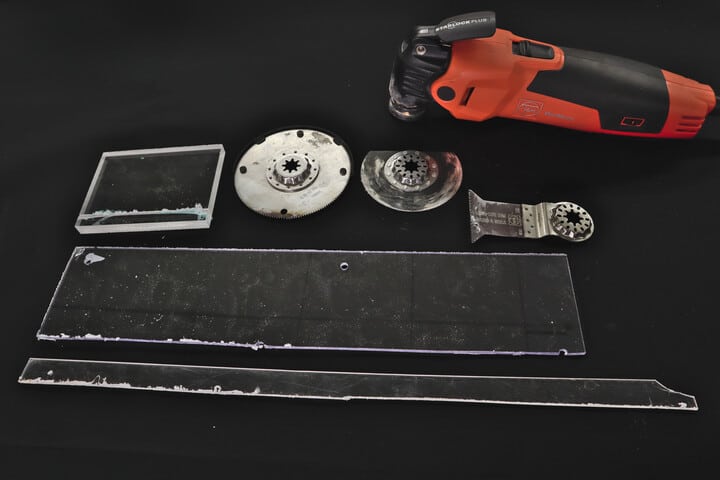
An oscillating multi-tool can be used to cut acrylic glass in all forms. This common transparent plastic is technically called polymethyl methacrylate (PMMA), but variously known as acrylic, acrylic glass, plexiglass, Lucite or Perspex. Compared to metals and ceramics, acrylic plexi is soft and easy to cut, but prone to melting and clogging up the blade. The best blades for cutting acrylic are bi-metal and carbon steel plunge-cut and segment saw blades intended for wood, which have large teeth and a substantial set for chip clearing.
The cutting capacity of oscillating multi-tools into acrylic is ultimately limited by the reach of the blade. Common plunge-cut blades with reaches from 1½” to 2” can easily cut through most common acrylic sheets and tubes from one side. Segment saw blades offer enough reach for most acrylic sheets, but do not usually have any set in their teeth and are more prone to clogging than plunge-cut blades.
To achieve a good cut quality into acrylic with an oscillating multi-tool, the main concern is to avoid melting the material. While a partially melting cut will successfully sever the pieces, it leaves ugly burrs onto the cut sides which are hard to remove cleanly. Material melting will also reduce cutting efficiency, particularly with thick sheets, so that cutting will become impractically slow well before the blade reach becomes limiting. Although a plunge-cut blade with a 2” reach should in theory allow you to cut through 2” thick acrylic, in practice you may struggle to get through a ½” sheet.
Apart from selecting a blade with large teeth (low TPI) and some set, material melting is best avoided by setting the oscillation speed low and keeping the feed rate high.
When cutting thin acrylic sheets you will have the additional problem of workpiece vibration, just as with sheet metal. Vibration will lead to poor cutting efficiency and may also cause kickback or other instabilities in the tool. To stabilize the cut, you can try either of these two techniques:
- Technique 1: Sandwich the acrylic sheet between two stiffer sheets of plywood, MDF, etc., so that the cut line is only slightly exposed. This technique is best suited for straight cuts.
- Technique 2: Clamp the acrylic sheet onto a sacrificial piece of plywood or particleboard, and make the cut some distance through the acrylic sheet. This technique is suited for all cut shapes, but potentially makes the clogging issue worse.
Personally, I have found plunge-cut blades easier to control than segment saws in cutting acrylic and other plastic sheets.
An oscillating multi-tool is much slower than circular saws or jig saws in cutting acrylic, and is not the best choice for long straight production cuts. It is also not well suited for sheets thicker than about ½”. However, it is very flexible, controllable and safe, and excellent for finishing work and making small details like cutouts and holes.
Polycarbonate
An oscillating multi-tool can be used to cut polycarbonate (PC, Lexan). As its appearance, its cutting properties with oscillating tools are similar to those of acrylic glass (plexiglass, PMMA), see above.
The main differences between the two is that, compared to acrylic, polycarbonate is both tougher and has a higher melting point. Although the higher toughness increases the amount of heat generated in the cutting process, the higher melting point seems to more than compensate for this in my experience so that melting is easier to avoid with polycarbonate.
Polyvinyl chloride (PVC)
An oscillating multi-tool can be used to cut polyvinyl chloride (PVC). In its rigid form, this thermoplastic is most commonly encountered in pipes, tiles and flooring. Although relatively hard for a thermoplastic polymer, it is still soft and easy to cut. PVC is best cut using bi-metal plunge-cut and segment saw blades intended for wood, which have large teeth and some set. Its cutting with an oscillating multi-tool is relatively similar to acrylic, and you should see the notes above.
The cutting capacity of oscillating multi-tools into PVC is limited by the reach of the blade. Common plunge-cut blades with reaches from 1½” to 2” can cut through most of the smaller PVC pipe used in construction working from one side. Segment saw blades with reaches 3/4” to 1” can easily cut all PVC tiles and flooring.
Just like acrylic and polycarbonate, PVC is prone to melting during cutting. Material melting will reduce both cutting efficiency by clogging up the blade teeth and the cut quality by creating large burrs. Like with PMMA and PC, you can try to avoid melting by using a plunge-cut blade with large teeth and set, a low speed setting and a high feed rate – see Acrylic above.
5 Composites
Carbon fiber reinforced polymer (CFRP, carbon fiber)
An oscillating multi-tool can be used to cut carbon fiber composite parts. Carbon fiber is hard and abrasive, and should preferably be cut with diamond or carbide blades. Both plunge-cut and segment saw blades as well as grit type saw blades can be used. Plunge-cut blades have higher cutting capacity and can cut carbon composite tubes from one side. Segment saws, on the other hand, are better for cutting sheets or shells.
NB: The carbon fiber dust generated in cutting carbon composites is hazardous both to people and electrical equipment. Although cutting with an oscillating tool probably generates somewhat less dust than many higher-speed methods, proper dust extraction and personal protection must be ensured.
Fiberglass (Glass fiber reinforced plastic, GFRP)
An oscillating multi-tool can be used to cut fiberglass. Although not quite as hard as carbon fiber, the glass fibers in fiberglass are relatively abrasive, and should preferably be cut with diamond or carbide blades. Both plunge-cut and segment saw blades as well as grit type saw blades can be used. Plunge-cut blades have higher cutting capacity and can cut glass fiber tubes or thick-walled sections from one side. Segment saws, on the other hand, are better for long cuts into sheets and shells.
NB: The glass fiber dust generated in cutting fiberglass composites is potentially hazardous to health. Although cutting with an oscillating tool probably generates somewhat less dust than many higher-speed methods, proper dust extraction and personal protection must be ensured.
